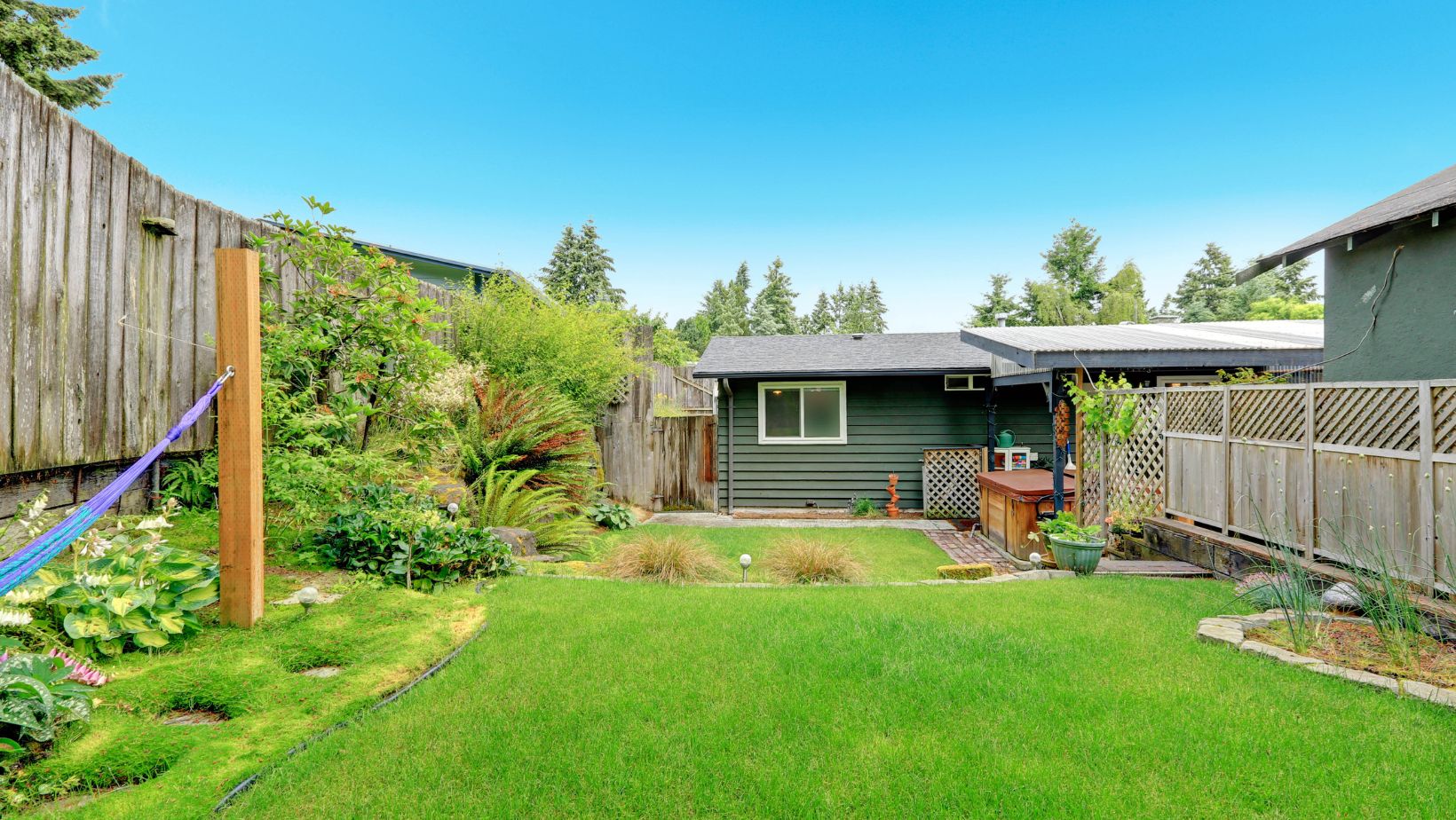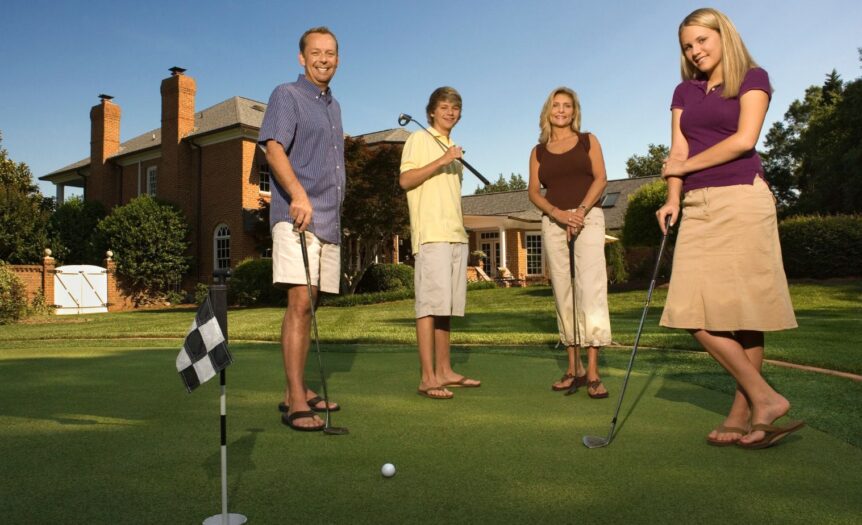In recent years, the world of golf has seen a remarkable shift, with more enthusiasts bringing the game closer to home.
The concept of home golfing, particularly in the form of backyard putting greens, has grown significantly in popularity.
This surge can be attributed to several factors, including the convenience of practicing at home, the ongoing global pandemic, which has encouraged many to seek recreational activities within the safety of their properties, and the increasing accessibility of home golfing equipment and technology.
Having a putting green in your own backyard comes with a plethora of benefits. It offers an excellent way to practice and improve your golfing skills conveniently.
Moreover, it’s a fantastic way to entertain guests and adds aesthetic value to your outdoor space. Additionally, for families, it provides a fun and engaging way to introduce children to the sport.
Understanding Your Space
Before diving into the creation of your personal putting green, the first step is assessing your backyard for space and suitability. Not all backyards are created equal, and the size and shape of your outdoor space will significantly influence the design of your golfing area.
When evaluating your backyard, consider the following:
- Space Availability: Determine how much of your backyard you can dedicate to the putting green. It doesn’t have to be large; even a small area can be transformed into a functional and enjoyable space.
- Terrain: Examine the terrain of your backyard. Ideally, the ground should be as flat as possible. However, slight undulations can add a challenge and more interest to your game.
- Sunlight and Shade: Observe the areas that receive adequate sunlight and those that are predominantly in the shade. This will affect both the choice of grass (for natural greens) and the overall experience of playing.
- Accessibility: Ensure that the space is easily accessible, not just for playing but also for maintenance purposes.
Tips for Design and Layout
Designing your backyard putting green requires a blend of practicality and creativity. Here are some tips to guide you:
- Start Small: If you’re new to this, start with a small, simple design. You can always expand later.
- Use the Natural Landscape: Work with the natural contours of your land. This can save on landscaping costs and give your green a more organic feel.
- Safety First: Ensure that the location of your green is safe, away from windows and other breakable items.
- Think Aesthetics: Consider the overall look of your garden. The putting green should complement, not detract from, the beauty of your outdoor space.
- Professional Consultation: If you’re unsure, consult with a landscape designer or a golf course architect.
Planning You’re Putting Green
Types of Putting Greens: Artificial vs. Natural
When planning your backyard putting green, one of the first decisions to make is whether to opt for an artificial or a natural green. Artificial greens are made from synthetic materials that mimic the feel of real grass.
They are low-maintenance, durable, and offer consistent playability year-round. On the other hand, natural greens require the planting and upkeep of real grass. They provide a more authentic golfing experience but demand regular maintenance like mowing, watering, and fertilizing.
Tools and Materials Needed for Construction
The tools and materials required for constructing a putting green depend largely on the type chosen.
For an artificial green, you will need synthetic turf, a base material like crushed stone, sand, landscaping fabric, adhesive, and infill material.
For a natural green, the requirements include topsoil, grass seed or sod, a lawn roller, and gardening tools.
Additionally, basic construction tools like shovels, tape measures, and a level are essential for both types.
Steps in Planning
The planning phase is crucial in ensuring the success of your putting green project. Start by measuring the area of your backyard you intend to convert.
This will help determine the amount of materials needed. Choosing the location is next, keeping in mind factors like sunlight, drainage, and accessibility.

Finally, design considerations come into play. Decide on the shape of the green, the number of holes, and any additional features like sand bunkers or contours.
Building the Putting Green
Step-by-Step Guide to Constructing a Putting Green
Building a putting green involves several steps. For an artificial green, it typically starts with preparing the base, laying down the landscaping fabric, installing the turf, and then adding the infill. Natural greens require soil preparation, planting the grass, and ensuring proper growth conditions.
Artificial Turf Installation vs. Growing Natural Grass
Choosing between artificial turf and natural grass impacts the construction process. Artificial turf installation is more about assembling and laying down materials.
It requires careful measurement and cutting of the turf, securing it in place, and ensuring a smooth, even surface.
In contrast, growing natural grass is a more organic process. It involves soil preparation, seeding or laying sod, and then patiently nurturing the grass to maturity.
Drainage and Landscaping Considerations
Regardless of the type of green you choose, proper drainage is vital to prevent waterlogging and maintain the quality of the playing surface. This might include installing drainage tiles or grading the land.
Landscaping is also an important aspect, not only for aesthetic reasons but also for integrating the green seamlessly into your backyard’s ecosystem.
Maintenance and Upkeep
Tips for Maintaining Artificial and Natural Greens
The key to a beautiful and functional putting green is regular maintenance, whether it’s artificial or natural. For artificial greens, maintenance includes brushing the turf to keep the fibers upright, removing debris, and occasionally replenishing the infill.
These greens also need to be washed periodically to remove dirt and pollen. In contrast, natural greens require more frequent care, including mowing, watering, aerating, fertilizing, and controlling weeds and pests.
Seasonal Care and Long-term Sustainability
Seasonal changes can affect your putting green. During spring and summer, natural greens may need more frequent mowing and watering, while in fall, it’s important to remove fallen leaves promptly to prevent decay and mold.
Winter care often involves protecting the green from frost and snow damage. Ensuring the long-term sustainability of your green means using eco-friendly practices such as water-efficient irrigation systems for natural greens and choosing high-quality, durable materials for artificial ones.
Enhancing Your Golfing Experience
Adding Features like Sand Traps, Slopes, and Flags
To make your backyard green more challenging and engaging, consider adding features like sand traps, slopes, and flags. Sand traps add a degree of difficulty and simulate the experience of a full golf course.

Incorporating slopes can help improve your putting skills by learning how to read and adapt to different angles. Flags not only add a professional touch but also serve as visual targets to aim for.
Using Technology for Improving Your Game
Modern technology offers various tools to enhance your golfing experience right in your backyard. Mobile apps can provide tips on improving your technique, track your progress, and even simulate playing on famous golf courses.
Sensors and wearable technology can analyze your swing, posture, and putting stroke, giving you valuable feedback for improvement. Integrating these technological aids can turn your backyard putting green into a state-of-the-art training facility.
Endnote
Turning your backyard into a personal golf course by installing a putting green is more than just a landscaping project; it’s an investment in your passion for the sport.
Incorporating technological advancements and customizable features like slopes and sand traps can elevate your experience, making your backyard green not just a practice area but a hub of entertainment and learning.
As golf continues to grow in popularity, particularly in home settings, your backyard putting green stands as a testament to your love for the game and a symbol of your dedication to improving your skills.






